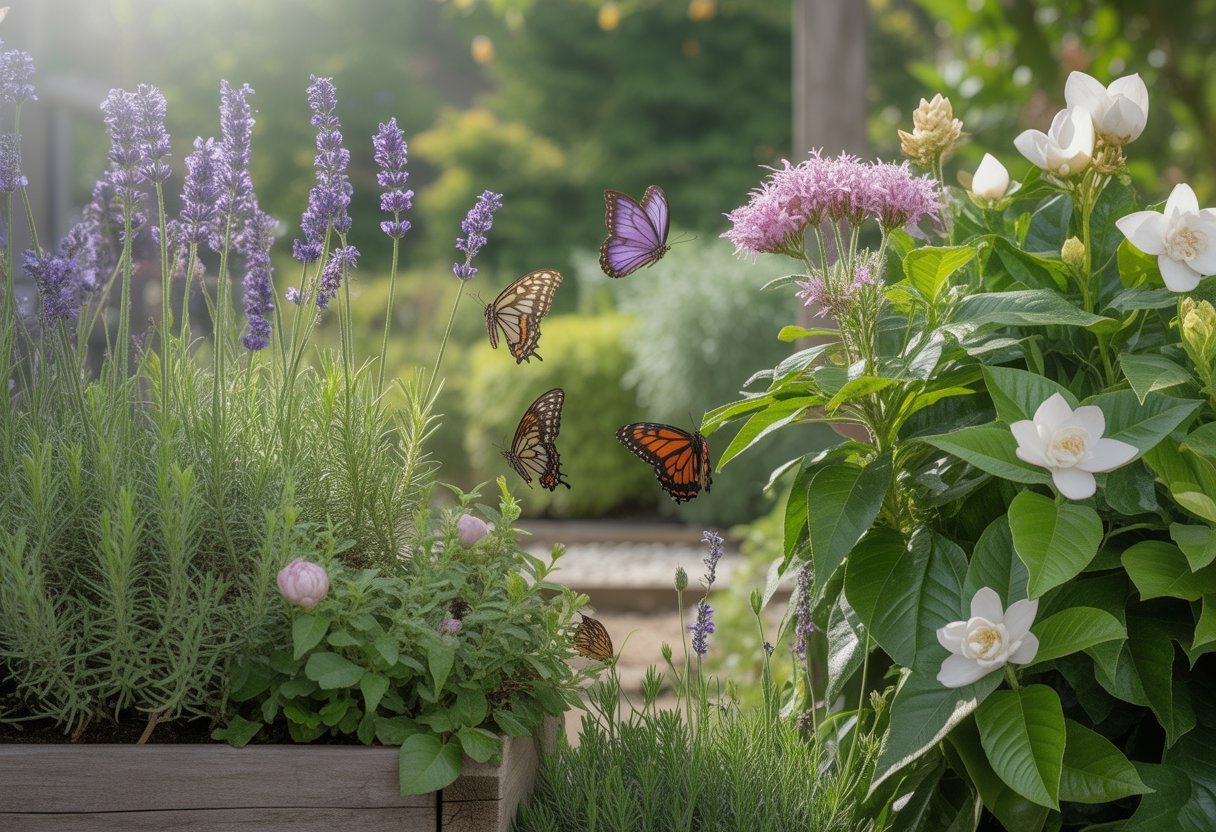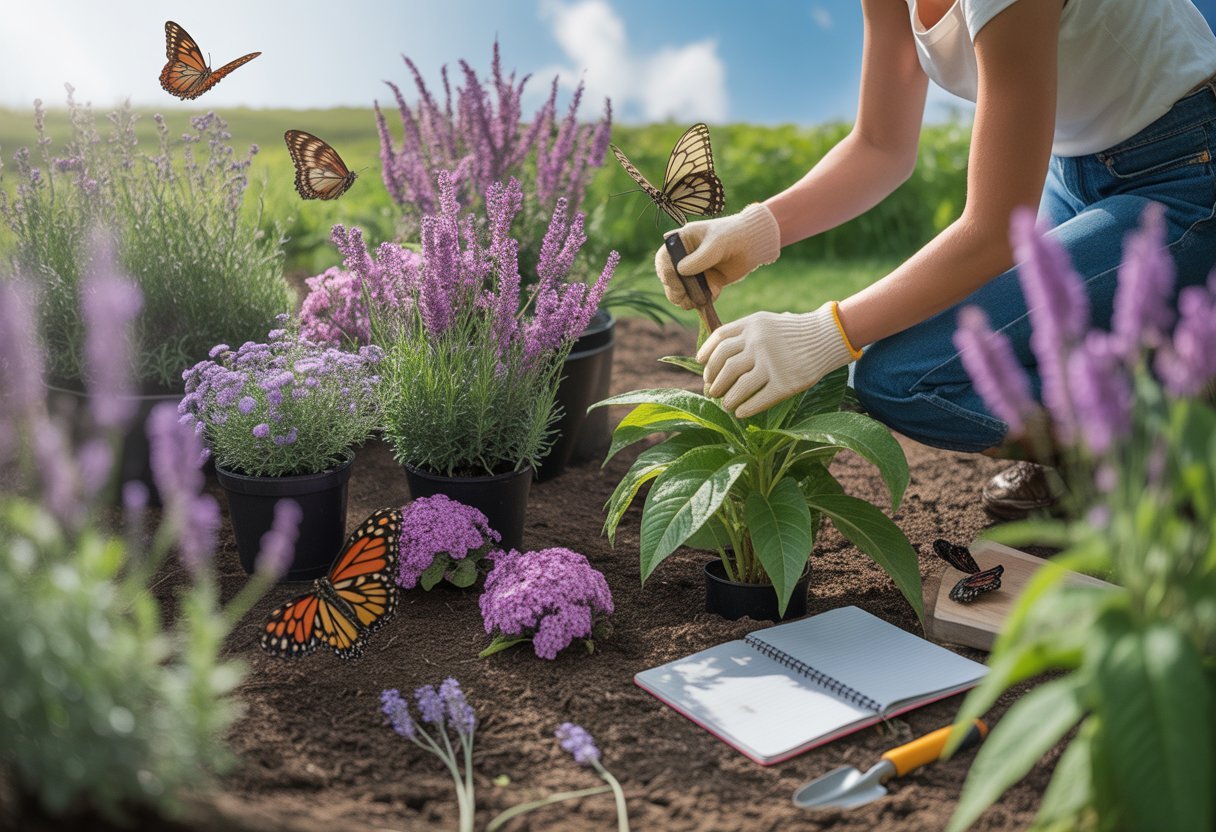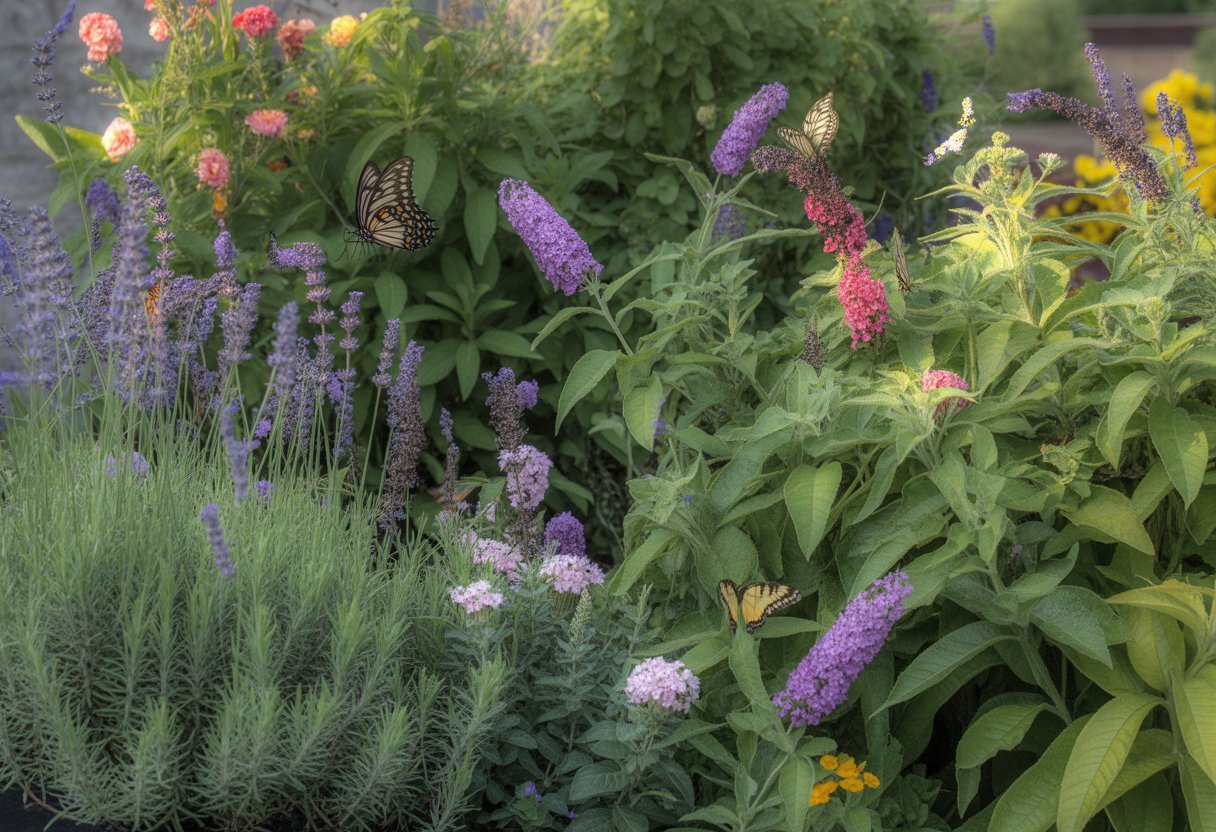Building a butterfly garden with fragrant plants is a rewarding way to bring more pollinators into your yard and add a sensory punch. Colorful, scented blooms do double duty: they draw in butterflies and support their life cycle by offering up nectar when they need it most. You get a garden that’s easy on the eyes and a haven for butterflies, which, let’s face it, could use a little help these days.

I’ve noticed that mixing fragrant nectar plants with host plants for caterpillars really keeps butterflies coming back. A blend of spring and fall bloomers means you’ll have butterflies flitting around for much longer. Picking your plants carefully and thinking about the layout makes the space lively for both butterflies and, honestly, for anyone who steps outside.
Selecting and Designing a Butterfly Garden Site

When I plan out a butterfly garden, I pay attention to sunlight, soil, and how I group the plants. These details can make or break how well your garden grows and how many butterflies you actually see.
Choosing Sunny Spots and Wind Protection
I always look for a spot that gets at least 6 hours of sun—no shortcuts here. Butterflies need the sun to get going in the morning, so a place with good morning light is perfect.
Wind is another thing I watch for. Natural barriers like shrubs or a fence help block strong gusts but shouldn’t throw too much shade. Butterflies seem to appreciate a calm spot as much as I do.
Ensuring Good Drainage and Soil Preparation
Standing water is a no-go for most butterfly-friendly plants. I lean toward sandy loam, but if I’m stuck with clay, I’ll mix in compost to help with drainage.
Testing the soil pH is worth the extra step—sometimes a little tweak makes all the difference for native plants. Healthy, balanced soil means better nectar and fewer plant problems down the line.
Garden Layout and Plant Clustering
I like to group the same types of plants together instead of spreading them out. Butterflies seem to find clusters faster, and it just looks fuller. Native, fragrant plants in groups are usually a hit with local butterflies.
Setting up a “puddling area”—basically a shallow, damp patch with sand—gives butterflies a place to pick up minerals. I try to keep flight paths open between flower clusters, and a punch of color and scent doesn’t hurt either.
Fragrant Nectar and Host Plants for Butterflies
I zero in on plants that feed both adult butterflies and their caterpillars. A good mix keeps the butterflies coming and helps them stick around. Plenty of fragrant flowers pull double duty as nectar sources and caterpillar hosts.
Best Nectar-Rich Flowers for Attraction
Nectar-rich flowers are the butterfly equivalent of a good coffee shop. Butterfly bush (Buddleia) smells great and draws in all sorts of species. Lavender and salvia are classics—aromatic and loaded with nectar.
You can’t go wrong with zinnias, goldenrod, and black-eyed Susans for a long bloom season. Coneflower (Echinacea purpurea) isn’t super fragrant, but butterflies love it for the nectar.
Mixing up flower colors and shapes—think asters, sunflowers, lantana—keeps things interesting and the butterflies coming back.
Essential Host Plants for Caterpillars
Host plants are non-negotiable if you want caterpillars to stick around. Milkweed is a must for monarchs, and it even has a gentle scent.
Fennel and parsley are favorites for swallowtail caterpillars. I like to throw in native asters too—they’re good for more than just nectar.
Host plants aren’t always the most fragrant, but they’re essential if you want to see the full butterfly life cycle in action.
Balancing Native and Exotic Plant Choices
I usually stick with native plants since they’re built for local conditions and butterflies recognize them. They’re also less needy when it comes to water and upkeep.
Still, a few exotics like marigolds or lantana can help fill in gaps, especially when you want more color or a longer bloom time. The trick is to mix them in without letting anything take over.
It’s all about balance—keeping things interesting for both butterflies and anyone hanging out in the garden.
Fragrant Annuals and Perennials
Annuals and perennials each bring something to the table. Lavender and salvia are perennials I rely on for steady scent and nectar.
For a quick splash of color and butterfly action, marigolds and zinnias are hard to beat in summer. Buddleia is another go-to shrub that handles full sun and brings in hummingbirds, too.
Perennials like coneflowers keep coming back, while annuals fill in the gaps. Mixing both keeps the garden lively all season.
Creating a Supportive Butterfly Habitat

If you want a butterfly garden that actually works, you’ve got to think about more than just flowers. Clean water, safe spots to hide, and ditching the chemicals all matter. Supporting other pollinators doesn’t hurt either—diversity makes everything healthier.
Providing Water Sources and Puddling Areas
Butterflies need shallow water and minerals, especially sodium. I usually fill a shallow dish with sand and keep it moist—nothing fancy, just make sure it doesn’t dry out.
Birdbaths with gentle slopes are good too, as long as you keep them clean and shallow. Place these in sunny, protected spots so butterflies can land without drama. Deep water is risky—nobody wants a soggy butterfly.
Incorporating Butterfly Houses and Shelters
I’ll add butterfly houses sometimes, but honestly, dense shrubs or broad-leafed plants do most of the work. I tuck shelters near these plants for extra protection, especially when the weather turns.
It helps if shelters face the morning sun. Too many structures can clutter things—open space is just as important as places to hide.
Supporting Other Pollinators
Butterflies aren’t the only pollinators out there. I plant nectar-rich flowers that bloom at different times so bees and hummingbirds get their fill, too.
Tubular flowers are great for hummingbirds, while flat-topped ones work for butterflies and bees. Mixing it up prevents the garden from turning into a monoculture, and honestly, it just looks better.
Maintaining a Chemical-Free Environment
Pesticides and herbicides are off the table for me—they do more harm than good. I pull weeds by hand and let ladybugs handle the aphids.
Compost keeps the soil healthy and the plants happy. Keeping things organic means the butterflies (and every other little critter) can thrive from caterpillar to adult.
Encouraging Diversity and Year-Round Interest
If you want to see more than just a couple of butterfly species, you’ll need to get intentional with your plant picks and timing. I aim for nectar and habitat options that keep butterflies coming back through every season—otherwise, what’s the point?
Attracting a Range of Butterfly Species
For variety, I plant a mix of fragrant flowers with different shapes and colors. Tubular blooms like lantana and butterfly bush are crowd-pleasers for monarchs and swallowtails. Host plants like milkweed are non-negotiable for monarch caterpillars.
Clustering plants helps butterflies find food, and keeping things chemical-free gives both adults and caterpillars a fighting chance. A few low shrubs or brush piles offer shelter when the weather turns or predators show up.
Seasonal Planting for Continuous Blooms
Keeping nectar available all year means picking plants that bloom in different seasons. Early bloomers like asters start things off, and mid-to-late season flowers like coneflowers and black-eyed Susans keep the show going.
Native plants usually make this easier since they’re adapted to the local climate and butterfly crowd. I stagger planting times and mix in annuals with perennials for a longer bloom period. With a little planning, you can have butterflies around from spring through fall, no problem.
Educational and Community Benefits
My butterfly garden’s become a bit of a hands-on classroom, honestly—watching caterpillars munch leaves and then, almost magically, seeing butterflies flutter out. It’s a real-life lesson in biodiversity and conservation, and I get a kick out of sharing it with neighbors or the occasional curious school group. When people start noticing how crucial it is to look out for butterflies—especially monarchs, which, let’s face it, need all the help they can get—it feels like the whole community wins.
I’m always nudging folks to try native and fragrant plants; they’re a solid bet for helping local wildlife. And if you can skip the pesticides? Even better. Healthier butterflies, happier gardens, and, before you know it, a patchwork of green spaces that make city life just a little more vibrant.




